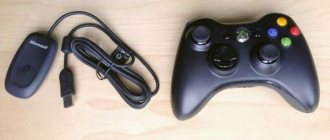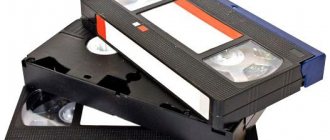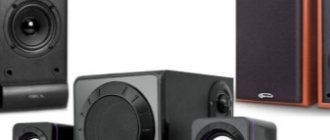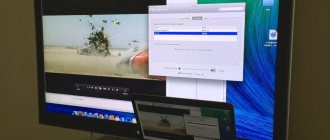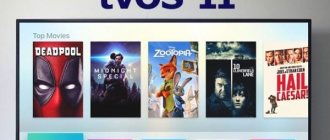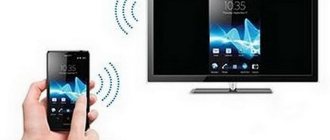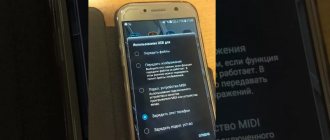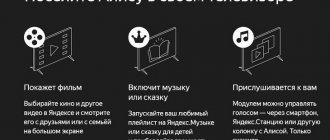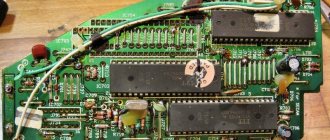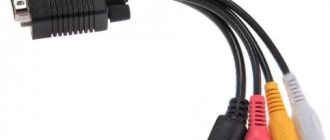What is scart on TV
The scart connector is needed so that you can easily connect other devices to the main information receiver. Video and audio signals come from it through the plugs. Today, almost all televisions are equipped with scart connectors. With their help, incoming digital and analog signals enter the device to reproduce images and sounds.
A scart port consists of twenty pins, each of which transmits or receives a specific signal. The edge of the scart, covered with a layer of metal, is the 21st pin, and is connected to the shielding braid of the cable. This design protects transmitted signals and neutralizes various types of interference.
Reference! The metal outer frame is made asymmetrically so that the scart connector can be connected to the socket without error.
Preparation and necessary wires
A description of connecting the tape recorder to the TV is available in the documentation for using the equipment. The connection of the plugs occurs in stages, but you may encounter the problem of not having the connectors necessary for the connection.
These devices use the following connections:
- RCA (tulip);
- coaxial cord;
- SCART cable;
- S-Video.
There should be no problems when connecting a cassette gadget to an old TV, but you won’t always find similar ports on modern TVs, so for connection you need adapters (adapters) that will simplify the connection process.
How to use the scart connector
Each scart port contact element serves only its intended purpose. In particular, the 4th pin is used to transmit audio signals, the 17th is for video signals, the 8th is for switching the internal signal to an external one, the 16th is for switching the TV receiver from RGB to Composite site mode.
To connect your PC to your TV using the scart Euro connector, you need to do the following:
- Take the cable and connect one end to the TV, the other to the PC (the required scart connector will be in the place where the video card is located).
- If everything is done correctly, the TV will become a PC monitor.
- Wait until a window pops up indicating that a new device has been found.
- Wait again while the PC installs the necessary software (drivers) to work with this device.
Sometimes it happens that the computer cannot install the required driver. Then a message appears that the device is not installed correctly. The problem arises for three reasons:
- No signal. In this case, either the problem is a poor-quality connector, or another electrical device is functioning that blocks data transfer. It is recommended to disconnect all third-party devices from the network.
- The video card is configured incorrectly or the driver is outdated. Here you should update the card software by using the Internet and visiting the corresponding website. But it is likely that this card cannot support data transfer through the scart connector.
- Insufficient horizontal sync signal, which cannot be less than 15 kHz. You need to resolder the adapter. You will also need to install additional software. Some of them will have to be paid for. Here it is better to seek advice from a specialist.
Please note that if your PC has a VGA connector, you will need a special cable.
Pinout
| Contact number | Purpose |
| 1 | Audio output, right channel |
| 2 | Audio input, right channel |
| 3 | Audio output, left channel (mono) |
| 4 | Audio, general |
| 5 | blue color of the image, general |
| 6 | Audio input, left channel (mono) |
| 7 | enter exit |
| 8 | U AT-TV switching |
| 9 | Green image color, general |
| 10 | Clock |
| 11 | Green image color, input/output |
| 12 | Data |
| 13 | Red image color, general |
| 14 | Data/Clock, general |
| 15 | Red image color, input/output |
| 16 | Fast Switch |
| 17 | Video, general |
| 18 | Fast Switch, general |
| 19 | Video output: composite or S-Video |
| 20 | Video input: composite or S-Video |
| 21 | Ground |
Connector topology
In terms of geometry and form factor, the connector is made in a plastic case with mandatory shielding. This design ensures high quality signal transmission without distortion. The interface is equipped with 21 pins
, including only analog lines for data transmission. The cable and supply wire must be shielded, which is important when designing certain models of equipment, guaranteeing high quality and stability of its operation.
The converter must be suitable for use
The digital flat-screen TV has become the standard in the living room and has long replaced tube glasses. This leads to connection problems. However, the interaction of old and new components with suitable accessories. Additionally, you must have a converter that can scale the image. For good converters you need to plan between 40 and 90 euros.
What can you buy?
At the very least, by scaling up the resolution or possible 3D presentation, the viewer can at least get the impression of an improvement in quality. If you own another with a resolution of 800×600 pixels, you can save buying a converter - the image cannot be projected onto a wall.
A little history
Before SCART appeared, there were many connectors, which created inconvenience when connecting devices of different brands.
In 1978, the subject of our conversation appeared, which combined previously existing interfaces. In 1981, in his homeland it was forbidden to sell televisions without such a socket. And after another 3 years it was accepted as a standard throughout Europe.
At that time, American and Asian equipment was equipped with a “tulip” cable. SCART became its competitor in the European market, and after a while - throughout the world.
RF interface
The RF type interface allows you to connect not only satellite broadcasting, but also cable television. The quality of transmission through this output does not have a good picture, so watching TV shows in high definition has the mesh ripples already familiar from “tulips”, as well as a problem with large diagonals of devices.
One of the main advantages of such an interface is the ability to connect the receiver to a second TV. The only condition that must be strictly observed is the presence in the set-top box of a high-frequency RF modulator and a corresponding output. But not all TV set-top boxes have such components. So keep this nuance in mind before connecting the Tricolor receiver to your TV, because many devices from this provider do not have this technical capability.
Read also: How much does it cost to spray paint?
How to avoid knocking down the antenna when connecting a VCR?
To connect a VCR to a TV without pulling out the cord, you need to purchase a set-top box that will act as an adapter, and also buy two RCA cables and one coaxial cable.
The connection is made as follows:
- Insert the coaxial cable into the Cable Out jack on the tuner and the RF In jack on the tape recorder.
- Connect the “tulip” plug to the Audio Out and Video Out outputs on the set-top box, and to the Audio In and Video In outputs on the tape recorder.
- Connect the remaining wires to the TV and video player, open the TV menu and find the “data broadcast source”.
- In the menu, find the name of the VCR and insert the cassette. If the connection is correct, the contents of the media will be displayed on the screen.
- Reboot the hardware.
It is important to remember that before performing any actions, the equipment should be turned off from the electrical network, this will prevent the possibility of a short circuit or equipment breakdown.
Those annoying 20 contacts and ground
As a rule, the connecting cord was a cable, on one side of which there was a SCART connector, on the other, two, four or six contact groups of the American standard RCA (called “tulips” for their specific shape). At its core, it was a simple adapter that allowed for galvanic connection of the source with a video monitor (TV). Owners of video equipment often cursed, cursing the imperialists for the lack of desire for universal standardization, believing that 21 contacts for such a simple device was too many.
Only television specialists, for whom the SCART connector diagram did not constitute a “Chinese letter”, were able to appreciate the full potential of this approach on the part of the French Union of Electronics Manufacturers, in honor of which it received its name (Syndicat Des Constructeurs D'Appareils, Radiorecepteurs Et Televiseurs - SCART).
( 1 rating, average 5 out of 5 )
Why is it so difficult? But why!
Unlike conventional “tulips”, the SCART RCA connector has a number of advantages that provide extensive control capabilities, better color reproduction and even digital broadcasting, unthinkable in the early 80s (it was developed in 1983).
Today, even consumers who are little educated in electronics know that the variety of colors on the screen is created by only three components: red, green and blue. Their separate supply to the color module eliminates a number of interferences and makes the picture clearer. This opportunity is provided by the SCART connector, in which the 7th, 11th and 15th pins are designed to supply an RGB signal, and the 5th, 9th and 13th, alternating with them, are intended for shielding shells.
But this is not all the capabilities that the SCART connector has. The pinout assumes the ability to automatically turn on and off the TV simultaneously with a low-frequency signal source (DVD or VCR), regardless of which company manufactured the equipment. The widescreen display mode also turns on independently.
In addition to these functions, there are two digital contacts - the 12th and 14th, prophetically identified by French engineers back in 1983, when almost all consumer electronics were analog. There is also a connector for connecting a timer, it is number ten.
So, 20 contacts and one common one (21 in total) - this turns out to be not so much. For modern entertainment video centers they are still sufficient, although they are no longer enough to enable Dolby Surround...
Article rating:
What is a scart connector on a TV Link to main publication
Related publications
- How to properly connect current transformers to the meter
SCART pinout
The abbreviation SCART (Syndicat des constructeurs d”appareils radio recepteurs et televiseurs) is translated from French as “Association of the Radio and Television Industry”. The European unified connector, developed at the very beginning of the eighties, was intended for connecting various devices: a TV with a printer in the Videotext system, a keyboard in the Teletext system, VCRs, video players and Hi-Fi devices, a home computer, etc. The SCART connector is used not only in all European-made devices, but also in most Japanese devices.
The simplest wiring
Wiring the SCART connector itself is not difficult, especially since the first video enthusiasts required the simplest functions. For those who only wanted to watch already recorded programs, three main contacts were enough: the second and sixth (a jumper was placed between them) were responsible for sound, the twentieth for video, and, of course, a ground contact (a plate surrounding the entire connector) was needed. The same applied to those who bought a player - the device is relatively inexpensive compared to a “full video recorder”. It should have been used with a 75-ohm frequency impedance, but in practice, given the short length, many manufacturers neglected this condition, especially since the recording quality of most cassettes left much to be desired, and the picture clarity was the least affected by the properties of the connector.
In order to provide the ability to record to the device from an external low-frequency source (another VCR or TV) in audio mono mode, the number of pins needed to be doubled, adding the 1st, 3rd (sound) and 19th (video) contacts.
Component port (Y/Pb/Pr).
Component input for receiving an analog signal to a TV. Transmits the following signals
- Y - transmits brightness level and clock pulses. are indicated by a yellow green circle.
- Pb - conveys the difference between the blue level and the brightness level, indicated by the blue circle.
- Pr - transmits the difference between the brightness level of red and is indicated by a red circle. Since the transmission to the component input signal is converted less, there is less loss in image quality compared to a standard RGB connection (SCART). Samsung in many models of modern TVs do not have RGB connectors, but only component ones. (AV) x 1 (Audio common to component) port.
Component or composite jacks can only transfer video to audio using a composite audio input.
How to check the connection?
After connecting the equipment, you should perform test work to ensure that the actions were performed correctly.
What to look for:
- If the connection is made with coaxial wire. You need to turn on the tape recorder and TV. When the TV screen goes into standby mode, you need to insert the cassette and start playing the video. If everything is in order, after turning off the equipment, the TV automatically switches to normal channel broadcasting. To further turn on the tape recorder, you need to press Play and select the number on which the VCR settings were saved.
- To test the RCA cable. You need to press the Source button on the player's control panel. The TV should then go into standby mode. If the connection does not occur, you should check that the plugs are installed correctly in the ports. The colors of the end switches must match the color scheme of the plugs. After that, you need to enter the AV menu, a video tape recording will be displayed on the screen, after which you should select the desired video and press the Play button.
- Scart cord. Allows you to connect devices simultaneously; to do this, use the Source button. The main panel will be displayed on the screen, where the subsequent settings for playing the videotape will be indicated.
Make sure that the wires are inserted tightly, this will affect the incoming signal, image quality and sound effects.
